April 25,1888-October 8th, 1953
‘Do not be struck by others’
‘Do not strike others’
‘The principle is the peace without incident’
Chojun Miyagi was born April 25th 1888 in Higashi-Machi (Naha-shi) Okinawa of a wealthy family who’s business was import/export primarily pharmaceuticals. Originally Chojun Miyagi was born as Miyagi Matsu however his name was changed to Chojun at the age of 5 by his uncle whom adopted him after the death of his father in 1893. His family owned two ships which made regular trips to mainland China, placing them among the wealthiest families in the area and enabled a young Chojun Miyagi Sensei to travel to China to study the style of his instructor and develop the style of Karatedo we call Gojuryu today. However his original Martial Arts training started with his neighbor Ryu Ko Aragaki (one of the very few fighters ever to beat the legendary Choki Motobu) at 11 years old. Ryu Ko Aragaki Sensei, before moving his family to Taiwan, later introduced him to Kanryo Higaonna, and he began training at the age of 15 in the fall of 1902 after fulfilling a host of chores (the traditional way of being accepted by an instructor).
- 1888, April 25 – Chojun Miyagi is born in Higashi-Machi (Naha-shi) Okinawa. His original birth name was Miyagi Matsu.
- 1893 – Chojun Miyagi Sensei’s father dies, he is 5 years old and is adopted by his uncle and his name changed to Chojun.
- 1899 – Chojun Miyagi Sensei begins his studies with Ryu Ko Aragaki Sensei.
- 1902, Chojun Miyagi Sensei is introduced to Kanryo Higaonna Sensei by Aragaki RyuKo Sensei who is Miyagi’s first teacher.
- 1902 – Both Kenwa Mabuni and Chojun Miyagi begin study with Kanryo Higaonna Sensei.
- 1915 – Chojun Miyagi Sensei, Eisho Nakamoto and Go Kenki (a Chinese tea merchant from Naha. Go Kenki was a Sifu (instructor) of White Crane and a very close friend of Miyagi, all traveled with Miyagi to China where Go Kenki also serves as their interpreter. This would be their first trip for research.
- 1917 – Kanryo Higaonna Sensei died in October at Nishiishin-Machi, 2-chome, Naha, Okinawa. Miyagi Sensei paid for his funeral. Chojun Miyagi Sensei returned to Okinawa at this time, due to the death of Higaonna Sensei.
- 1918 – Chojun Miyagi Sensei formed the Ryukyu Toudi Kenkyu-Kai (Toudi-which means China Hand) to ensure the preservation of Karatedo as an Okinawan treasure. The Club was established in Asahigoaka, Wakasa-cho, and Naha-Shi. The co-founders were Chojun Miyagi Sensei, Hanashiro Chomo, Motobu Choyo and Kenwa Mabuni.
- 1921 – March 6th, The Okinawan Department of Education, requests Chojun Miyagi Sensei and Funakoshi Sensei to demonstrate Toudi to oncoming Prince Hirohito.
- 1921, March 10th – Miyagi Sensei (Naha Te) and Funakoshi Sensei (Shuri Te) demonstrate Toudi to Prince Hirohito (who would later become Emperor of Japan – WWII),
- 1926 – Hanashiro Chomo Sensei reorganizes the Ryukyu Toudi Kenkyu-Kai (Toudi-which means China Hand) to ensure the preservation of Karatedo as an Okinawan treasure. The Club was established in Asahigoaka, Wakasa-cho, and Naha-Shi. The co-founders were Chojun Miyagi Sensei, Hanashiro Chomo, Motobu Choyo and Kenwa Mabuni.
- 1927 – Chojun Miyagi Sensei what had happened. After much thought, Miyagi Sensei named his system Gojuryu after a line from a poem in the book Bubishi, which reads “Ho Go Ju Donto”; the way of inhaling and exhaling is hardness and softness.
- 1929 – Meitoku Yagi Sensei begins training with Chojun Miyagi Sensei.
- 1929 – Gogen Yamaguchi Hanshi and friend Jitsuei Yogi wrote to Chojun Miyagi inviting him to Japan. Gogen Yamaguchi Hanshi later received introduced to Chojun Miyagi by Yogi Jitsuei (September 27, 1912 – November 1997) for direct study.
- 1929, April – Karatedo is adopted into the Okinawa Police Training school and Naha Municipal Commercial High School as taught by Chojun Miyagi Sensei.
- 1929 – Chojun Miyagi Sensei became a Karatedo instructor at Training Center of Okinawa Police Department and Naha Municipal Commercial High School.
- 1930 – Chojun Miyagi Sensei named Karatedo Division Chairman of the Okinawan Prefecture Athletic Association.
- 1930 – Chojun Miyagi Sensei received an invitation to demonstrate at the All Japan Martial Arts Demonstration (pre Gogen Yamaguchi) to be held on May 5, 1930.
- 1930 – (Official Recorded Date) Chojun Miyagi Sensei becomes the first to give his style of Karatedo a formal name, calling it Gojuryu (See also 1927!).
- 1931 – According to Gogen Yamaguchi in his autobiography, this is the year that Jitsuei Sensei introduced Yamaguchi Sensei to Miyagi (although he was first invited in 1929).
- 1933 – Chojun Miyagi Sensei officially registers Gojuryu with the Dai Nippon Butokukai as a Ryuha
- 1933 – Chojun Miyagi Sensei was appointed Chief of Karatedo for the Okinawan branch of the Butokukai. Butokukai awarded him the title of Kyoshigo [Shihan-Kyoshi], 2nd highest title.
- 1934, March 23rd – Chojun Miyagi Sensei writes his “Karatedo Gaisetsu” (Outling on Karatedo ). He would later present it in Japan in 1936.
- 1934 – Chojun Miyagi Sensei becomes a permanent officer of the Dai Nippon Butokukai (Great Japan Martial Virtues Association).
- 1934 – Chojun Miyagi lectures and teaches Karatedo in Hawaii on the Invitation of Yokoku Jihosha. The trip is also supported by business-men Chinyei Kinjo, Seichu Yamashiro and Seisho Tokunaga.
- 1935, February – Chojun Miyagi Sensei returns to Okinawa from Hawaii.
- 1935, Miyagi Sensei gives his second demonstration in Japan (by invitation Gogen Yamaguchi), with Yogi Jitsuei Sensei as his assistant. While in Japan, Miyagi Sensei stayed in Jitsuei Sensei’s apartment.
- 1935 – Miyagi Sensei visits Ritsumeikan University in Kyoto. Current members included Jitsuei Yogi, Gogen Yamaguchi and Soh Nei Choo (who would later teach Masutatsu Oyama)
- 1936, January 28 – Chojun Miyagi Sensei gives a demonstration in Osaka, Japan. It is here that Miyagi Sensei presented his ‘Outline on Karatedo ‘ (Karatedo Gaisetsu) speech regarding Karatedo and its benefits.
- 1936 – Miyagi Sensei was awarded the Meiyo Shihan (Honorary Master Teacher) and Yogi Jitsuei and Gogen Yamaguchi were awarded Shihan-Dai (Assistant Master Instructors) by the Dai Nippon Butokukai.
- 1936, November 28 – Chojun Miyagi presented to club members his essay “Ryukyu Kenpo Karatedo Enkaku Gaiyo”, part of his ‘about Karatedo ‘ Lecture and demonstration at Meiji Shoten
- 1936 – Chojun Miyagi receives a medal for “Excellence in the Martial Arts” from the Japanese Ministry of Education.
- 1936 – Chojun Miyagi Sensei, Eisho Nakamoto and Go Kenki (a Chinese tea merchant from Naha. Go Kenki was a Sifu (instructor) of White Crane and a very close friend of Miyagi, all traveled with Miyagi to Shanghai China where Go Kenki also serves as their interpreter. This would be their 2nd trip for research and they would visit the Seibu Dai Iku Kai (Great Gymnastic Association, Pure Martial Arts Spirit) for research purposes.
- 1937, May 5 – Japanese Publishing company Takenori Kai sponsors the Takenori Festival where Chojun Miyagi Sensei performes Kata at Butoku Sai under the auspices of Dai Nippon Butokukai and is was given the title Karatedo jutsu Kyoshi first time in this nation.
- 1937 – Chojun Miyagi Sensei receives a Kyoshi degree from the Dai Nippon Butokukai.
- 1937 – Chojun Miyagi, along with other stylists, forms the Dai Nippon Butokukai Karatedo Jukkyoshi (Great Japan Martial Arts Karatedo Teachers Association).
- 1938, April – Chojun Miyagi Sensei was appointed as a Karatedo instructor at Okinawa Teacher Training School.
- 1939 – Shozo Ujita Sensei visits Okinawa and trains with Chojun Miyagi Sensei.
- 1940 – Chojun Miyagi and Shoshin Nagamine (Founder of Matsubayashi Shorin Ryu) created the Gekisai Kata to standardize Karate, making it easier to learn the basics of Karate. Chojun Miyagi Sensei later adds a 2nd Kata, Gekisai Dai Ni.
- 1942 – Miyagi Sensei was invited to teach at Ritsumeikan University (not by Yamaguchi Sensei as he was still in China at this time however by Jitsuei Yogi Sensei and Shozo Ujita Sensei).
- 1942 – Chojun Miyagi Sensei visits Kyoto Japan for teaching Karatedo . This would be the last time Miyagi was ever to return to Kyoto
- 1945 – Chojun Miyagi Sensei is reappointed (With establishment of Okinawa Public Government) to an instructor at Police Academy.
- 1945 – Chojun Miyagi was made an official of the Okinawa Minsei Taiiku Kan (Okinawa Democratic Athletic Association).
- 1947 – Miyagi Sensei returned to Naha and began teaching at the Naha Police Academy.
- 1951 – Miyagi Sensei began accepting a few students again at his garden Dojo. Prior to this, the only two students who trained regularly at his Dojo were Miyagi An’ichi and Aragaki Suechi.
- 1952 – Some of Miyagi Sensei’s former students began to return from the war and resume training.
- 1953, October 8 – Miyagi Sensei dies, never having named a successor or given anyone an official Black Belt.
After years of training with Higaonna Sensei, Miyagi sailed to China in May of 1915 in search of his Higaonna’s teacher. This was one of three trips he made to China during his lifetime. Upon his quest he studied Chuguko Kempo (Chinese Fist) in Fouchow, Fukien Province, from 1915 to 1917. He returned to Okinawa due to the death of Higaonna Sensei. In early 1917, Kanryo Higaonna Sensei died (at Nishiishin-Machi, 2-chome, Naha Okinawa). Chojun Miyagi Sensei paid for his funeral.

When he returned to Okinawa, he began to teach his Karatedo at a number of places in and around Naha, and to lecture and demonstrate throughout Japan Miyagi-Sensei subjected the art of Naha-te, as received from Kanryo Higashionna, to scientific examination. He studied the basic Go (Sanchin) and the six rules and created the Ju (Tensho) form, combining soft and hard movements. He also organized the auxiliary movements to strengthen the body through calisthenics. He organized these exercises in preparation for practicing the classical Kata. It can be said, he formulated the theory for the practice of Karatedo and organized it as an educational subject, an art of self-defense, and as a spiritual exercise. From the old Chinese book Wu Pei Chih (Army account of Military Arts and Science) published in 1636, Miyagi took the expression Gojuryu for the name of his school as it appears in the sentence: The successful methods required both give and take (Go and Ju). Miyagi Sensei was the first instructor to officially give his style a name in 1927 apart from the city in which it was practiced (See Historical review of Gojuryu), and organize a school of Karate. Miyagi often used the slogan Nanji Kyokuden, meaning to “apply all Strength, be determined in everything that one does; defeat is not the end; losing is not the end of everything.” He was called the last great samurai warrior of Okinawa because of his legendary strength and skill as well as his intense dedication to the martial arts.
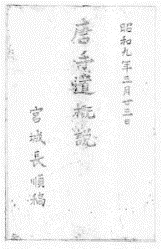 Although a somewhat quiet man he was noted for his very large and muscular hands (the Gojuryu Fist as sketched by Gogen Yamaguchi Sensei was a depiction of Chojun Miyagi Sensei’s fist) as well as being the senior most student of Kanryo Higaonna. On his pilgrimage to the Chinese mainland he studied not only the building blocks of his teachers art Hung Gar-Shaolin Chuan Chi-Chi, but also I-Chuan, Pa Kua Chang and Tai Chi Chuan. All softer however highly skilled and effective styles. It was at this time he learned the Kata or Quan Rokkishu which later became the building block on Kata Tensho. With this additional martial art training Okinawa-te, Naha-te and the Chinese arts Sensei Miyagi developed a refined form of empty hand, and even today its Whooping Crane Chinese Gung Fu roots can still be seen in its forms or Kata. A story is told that while visiting a temple in China, Chojun Miyagi noticed a crane sitting on a roof, which was made of tile. As he approached the huge bird, the crane became alarmed and flew away. As it was flying away, the frightened crane flapped its wings against the tile roof, breaking some of the tiles in the process. Miyagi was amazed that the soft feathers of the crane were able to break something as hard as tiles. With that as the beginning, he devised a whole new approach to Karate, mixing in with the hard techniques many soft ones to be used in countering hard blows and kicks.
Although a somewhat quiet man he was noted for his very large and muscular hands (the Gojuryu Fist as sketched by Gogen Yamaguchi Sensei was a depiction of Chojun Miyagi Sensei’s fist) as well as being the senior most student of Kanryo Higaonna. On his pilgrimage to the Chinese mainland he studied not only the building blocks of his teachers art Hung Gar-Shaolin Chuan Chi-Chi, but also I-Chuan, Pa Kua Chang and Tai Chi Chuan. All softer however highly skilled and effective styles. It was at this time he learned the Kata or Quan Rokkishu which later became the building block on Kata Tensho. With this additional martial art training Okinawa-te, Naha-te and the Chinese arts Sensei Miyagi developed a refined form of empty hand, and even today its Whooping Crane Chinese Gung Fu roots can still be seen in its forms or Kata. A story is told that while visiting a temple in China, Chojun Miyagi noticed a crane sitting on a roof, which was made of tile. As he approached the huge bird, the crane became alarmed and flew away. As it was flying away, the frightened crane flapped its wings against the tile roof, breaking some of the tiles in the process. Miyagi was amazed that the soft feathers of the crane were able to break something as hard as tiles. With that as the beginning, he devised a whole new approach to Karate, mixing in with the hard techniques many soft ones to be used in countering hard blows and kicks.
In 1929 Gogen Yamaguchi invited Mr. Miyagi to visit Japan and he later named Mr. Yamaguchi the leader of the Gojuryu schools in mainland Japan. That same year 1929) he was named as Shihan of the Okinawan Police and of the Naha School of Commerce (The Municipal Commercial High School – the general education program of Okinawa). Chojun Miyagi was named Karatedo Division Chairman (Chief) of the Okinawan Prefecture Athletic Association in 1930 and became a permanent officer of the Dai Nippon Butokukai (Japan Martial Virtues Association).
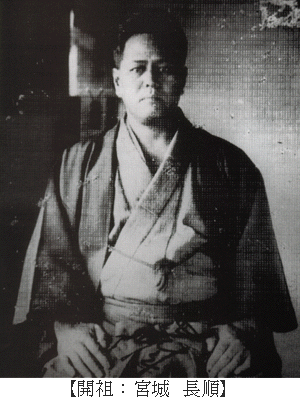 Although, Jigoro Kano (founder of Judo and the Kokokan) began visiting Okinawa in 1927, he was so impressed with Miyagi Sensei, he invited him to Japan in 1930 and 1932 to demonstrate at several meetings. It was at one of these meetings that one of his senior students, Jin’an Shinzato was asked which school of karate he belonged to. Unable to answer (styles were only known by their geographical reference at that time), he approached Sensei Miyagi, who agreed that a name should be chosen for their unique style.
Although, Jigoro Kano (founder of Judo and the Kokokan) began visiting Okinawa in 1927, he was so impressed with Miyagi Sensei, he invited him to Japan in 1930 and 1932 to demonstrate at several meetings. It was at one of these meetings that one of his senior students, Jin’an Shinzato was asked which school of karate he belonged to. Unable to answer (styles were only known by their geographical reference at that time), he approached Sensei Miyagi, who agreed that a name should be chosen for their unique style.
Chojun Miyagi Sensei worked hard to spread Karatedo throughout Okinawa and mainland Japan, and to earn Naha-te a status equal to that of the highly respected Japanese martial arts of Judo and Kendo. To achieve this he traveled frequently to mainland Japan where he was invited to teach Karatedo at Kyoto University and Ritsumei Kan University.
In 1933 Karatedo was registered at the Butokukai, the center for all martial arts in Japan. This was a milestone for Karatedo as it meant that it was recognized on a level with the highly respected martial arts of Japan.
On March 23, 1934, Chojun Miyagi wrote the document Toudijutsu Gaisetsu (‘An Outline of Karatedo ’) very rare to find and very technical on the almost spiritual training associated with Karatedo .
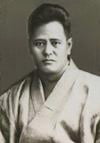 One month later in April, 1934 – Yokoku Jihosha invited Chojun Miyagi Sensei to Hawaii to lecture and teach until February, 1935. Chojun Miyagi on Thursday, May 3, 1934 aboard the NYK steamship. The trip is also supported by business-men Chinyei Kinjo of the Yoen Jiho Sha on Kauai, Seichu Yamashiro and Seisho Tokunaga. Chinyei Kinjo was the son of Chinzen Kinjo, one of the first immigrants to arrive in 1900 on board the ‘SS City of China’ and a previous student of Chojun Miyagi.
One month later in April, 1934 – Yokoku Jihosha invited Chojun Miyagi Sensei to Hawaii to lecture and teach until February, 1935. Chojun Miyagi on Thursday, May 3, 1934 aboard the NYK steamship. The trip is also supported by business-men Chinyei Kinjo of the Yoen Jiho Sha on Kauai, Seichu Yamashiro and Seisho Tokunaga. Chinyei Kinjo was the son of Chinzen Kinjo, one of the first immigrants to arrive in 1900 on board the ‘SS City of China’ and a previous student of Chojun Miyagi.
During this time he also becomes a permanent officer of the Dai Nippon Butokukai (Great Japan Martial Virtues Association).By 1936 Mr. Chojun Miyagi is truly recognized by the Government of Japan with being awarded the medal for “Excellence in the Martial Arts” from the Japanese Ministry of Education. That same year he went to train at the Chinese martial arts in Shanghai at the Seibu Dai Iku Kai or Great Gymnastic Association – Pure Martial Spirit. On May 5th, 1937 – Chojun Miyagi Sensei performed Kata at the Butoku Sai for the Dai Nippon Butoku-kai. Following what is now known as the Meeting of the Masters, Mr. Miyagi along with others who attended formed the ‘Great Japan Martial Arts Karatedo Teachers Association’ or ‘Dai Nippon Butokukai Karatedo Jutsu-Kyoshi’(1937). The first ever awarded in Japan.
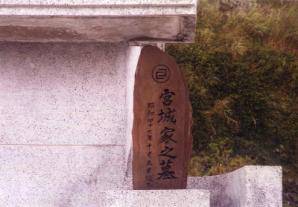 After returning to Okinawa Miyagi Sensei, now teaching in his Dojo again as well as teaching Okinawa school Children, creates the Kata Gekisai Dai Ichi (1) and Ni (2). Chojun Miyagi’s students primarily studied four Kata: Sanchin, Sesan, Seiunchin and Tensho. These Kata are called the Kaishu forms but the Kata Sesan and Seiunchin were actually considered the training Kata of Gojuryu. These are very important Kata and must be thoroughly studied to understand Gojuryu. As of April, 1938 – Chojun Miyagi Sensei was appointed to a Karatedo instructor at the Okinawa Teacher Training School. In 1940 Chojun Miyagi and Shoshin Nagamine (Founder of Matsubayashi Shorin Ryu) created the Gekisai Kata to standardize Karate, make it easier to learn and to prepare young Okinawa for National service. There is a theory that for this latter reason (Military service) Gekisai Dai Ichi ends with a forward step instead of a backward one as well as punches Jodan instead of Chudan.
After returning to Okinawa Miyagi Sensei, now teaching in his Dojo again as well as teaching Okinawa school Children, creates the Kata Gekisai Dai Ichi (1) and Ni (2). Chojun Miyagi’s students primarily studied four Kata: Sanchin, Sesan, Seiunchin and Tensho. These Kata are called the Kaishu forms but the Kata Sesan and Seiunchin were actually considered the training Kata of Gojuryu. These are very important Kata and must be thoroughly studied to understand Gojuryu. As of April, 1938 – Chojun Miyagi Sensei was appointed to a Karatedo instructor at the Okinawa Teacher Training School. In 1940 Chojun Miyagi and Shoshin Nagamine (Founder of Matsubayashi Shorin Ryu) created the Gekisai Kata to standardize Karate, make it easier to learn and to prepare young Okinawa for National service. There is a theory that for this latter reason (Military service) Gekisai Dai Ichi ends with a forward step instead of a backward one as well as punches Jodan instead of Chudan.
Before the Second World War, Chojun Miyagi traveled widely and was involved in many projects to spread Karatedo throughout mainland Japan and the rest of the world. However, from 1948 until 1953 he remained in Okinawa. Before the war he had been dedicated to his own training and research, to further develop the art of Gojuryu Karate, but his purpose in life had now changed. He was intent on passing on Gojuryu, and the “gokui” (secret principles) of Gojuryu to the next generation.
 For reasons mostly pointing to WWII, may students of Tsuboya-cho (a district of Naha) garden dojo returned for training in in 1951. As well, new students once more began to enroll.
For reasons mostly pointing to WWII, may students of Tsuboya-cho (a district of Naha) garden dojo returned for training in in 1951. As well, new students once more began to enroll.
For reasons mostly pointing to WWII, may students of Tsuboya-cho (a district of Naha) garden dojo returned for training in in 1951. As well, new students once more began to enroll.
Chojun Miyagi Sensei had four boys and five girls. Miyagi Tsuru was the oldest daughter and first born. Master Miyagi taught at his home, outside in his Garden Dojo. But he didn’t teach regularly outside his own personal students other than his municipal duties (Police and education). He would occasionally goto the Butoku-den in Naha (The Butoku-den was one of the few buildings that survived the World War II battles on Okinawa).
Naha’s Central Police buildings were rebuilt near the Butoku-den, which was torn down in the late l980’s. A bronze bust of Chojun Miyagi was put up in the Butoku-den and was moved to the Naha Police Headquarters in 1987.
Chojun Miyagi Sensei instruction was not limited to physical training. Miyagi Sensei also lectured his students on history, culture, society, human relations as many senior Sensei of today do. During these ‘sessions’ Chojun Miyagi Sensei would teach the kata (forms) in great detail and explain the “bunkai” (kata applications) thoroughly.
Chojun Miyagi dedicated his whole life to karate. He was responsible for structuring Naha-te (which he later named “Gojuryu”) into a systematized discipline which could be taught to society in general. This teaching system which he formulated enabled Karatedo to be taught in schools for the benefit of the young, and to reach vast numbers of people throughout the world. However, his private teaching at his home remained strictly in adherence to the principles of his teacher, Kanryo Higaonna, and his teacher before him, Ryuruko.
Miyagi never awarded anyone a Black Belt. He was in the process of formulating requirements for the Black Belt however he died before he completed this. He had not conceded a sucessor at the time of his death. Leaving an unprecedented mark in the world of Karatedo and from his famous Garden Dojo and enough legendary students to carry his name into the history books of Martial Arts as the ‘Master”.
Jin’an Shinzato Sensei (aka ‘Jiru’), an exceptional talent, was the probable successor to the Goju school in Okinawa, he was tragically killed during the Second World War. It is generally an excepted theory that Shinzato Jin’an Sensei would have been the obvious successor to Chojun Miyagi Sensei had not his death. Later, after the war, Meitoku Yagi Sensei was awarded the training uniform (Do Gi) and Belt (Obi) of Chojun Miyagi Sensei by his wife and daughter.
Chojun Miyagi passed away October 8th, 1953, leaving his family of 10 children, wife and a great legacy behind. He dedicated his entire life and fortune to Karate. He predicted that during the twentieth century Karatedo would spread throughout the world. Today we can see that this prediction has been realized; Karatedo is not only practiced in Japan, but it can be found throughout the countries of the world. Karatedo can no longer be referred to as a solely Okinawan or Japanese martial art, but it has become an art with no boundaries, an art for all nations and all peoples of the world. Four of his students, Seiko Higa, Meitoku Yagi (Meibu-Kan Gojuryu Karatedo Do), Seikichi Toguchi (Shoreikan Gojuryu Karatedo ) and Ei’ichi Miyazato (Jundo-Kan Gojuryu Karatedo ) carried on with Miyagi Sensei’s original teachings. The four students formed an organization named the ALL Okinawa Gojukai, which was a reorganization of the old Goju Rui Shinko-Kai. They established a promotional ranking system for the art of Karatedo .

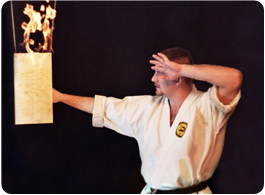

Can you send me link to your web site so that we can quote this? We are transfering all articles from old site karate.org.yu